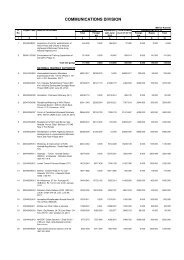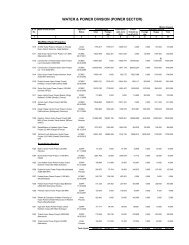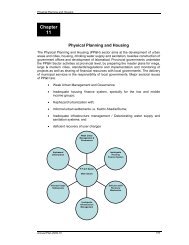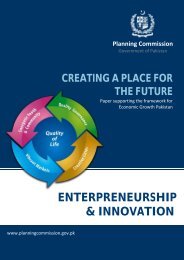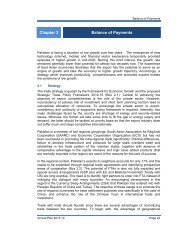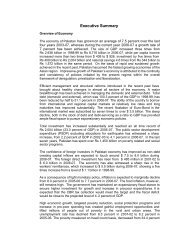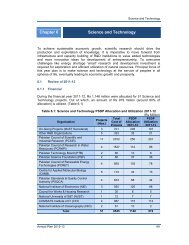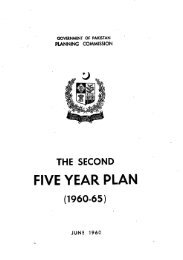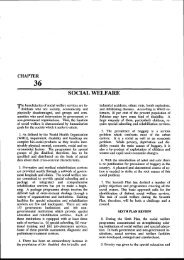Framework for Economic Growth, Pakistan - Planning Commission
Framework for Economic Growth, Pakistan - Planning Commission
Framework for Economic Growth, Pakistan - Planning Commission
You also want an ePaper? Increase the reach of your titles
YUMPU automatically turns print PDFs into web optimized ePapers that Google loves.
International conference on “<strong>Framework</strong> <strong>for</strong> <strong>Economic</strong> <strong>Growth</strong>, <strong>Pakistan</strong>”intra-regional trade has been rising rapidlyand now accounts <strong>for</strong> more than half of tradein manufactured goods – up from 40 percent in 1994- 95 (ADB, 2009). In other subregions,such as South Asia and CentralAsia, the level of intra-regional trade is low.These are impressive potential gains waitingto be tapped. The recent experiences ofIndia-Sri Lanka FTA are striking since theyhighlight the potential of bilateral trade tostrengthen supply capabilities leading tocorrection of trade imbalances. Since theoperationalization of the FTA, Sri Lanka‘sexports to India have grown by 132 per cent.After the global crisis Asian countries havetried to re-balance their economicorientation towards more reliance ondomestic demand. This is a necessaryrebalancing <strong>for</strong> the larger Asian economies.But <strong>for</strong> the smaller and medium sized Asiancountries trade with developed countries andintra-regional trade still remains a veryimportant engine <strong>for</strong> growth. <strong>Pakistan</strong>, in myview, has huge unexploited potential <strong>for</strong>more trade both globally and regionally; andas outlined in the New <strong>Growth</strong> Strategy<strong>Pakistan</strong> will need to become more open andbuild up its competitiveness to achieve thatpotential. The new growth strategy rightlypoints out that it‘s not an issue ofgovernment vs. markets but insteadgovernment and markets working together.The Asian state-led development successhas occurred because of a strong and smartstate not a large one. It has come because ofa partnership between state and market tobuild competitiveness and improveproductivity. It has not come by dismantlingthe state but by changing its role from directproducer to regulator and guide as anenabler. We need an active, smart, effectivestate <strong>for</strong> efficient and vibrant markets.<strong>Pakistan</strong>‘s New <strong>Growth</strong> Strategy points outin the right direction, highlighting the need<strong>for</strong> public sector re<strong>for</strong>m and the importanceof reducing the costs of doing business, inorder to develop more vibrant markets.Access to finance will play a key role in thisef<strong>for</strong>t, as well as reducing the timeit takes <strong>for</strong> business startups throughremoval of red-tape and artificialrestrictions. <strong>Pakistan</strong>‘s 18th amendmentbrings the state closer to the people but itnow requires building sufficient capacity atthe local level to carry out the newlyexpanded responsibilities and adequatecoordination between various levels ofgovernment.<strong>Pakistan</strong>‘s <strong>Framework</strong> <strong>for</strong> <strong>Economic</strong> <strong>Growth</strong>correctly highlights the role of vibrant cities.Well functioning cities are the engine ofdynamic innovation and efficient modernlife. They are the springboards <strong>for</strong> new ideasand a better life <strong>for</strong> <strong>Pakistan</strong>’s rapidlygrowing population. At the same time withsuch a large population still dependent onagriculture and living in rural areas it isimportant that the rural-urban divide doesnot become too large. Even by 2035 almosthalf of <strong>Pakistan</strong>‘s population will still beliving in rural areas and must feel includedin its growth processes. If the goal of highsustainable and robust growth is to berealized, there is urgent need <strong>for</strong> policiesthat not only would address how to increaseeconomic efficiency but also the differentconcerns of the rural poor and the urbanpoor. Failure to do so would make citiesuninhabitable, with pressures on water,transportation, fuel and power, and countriessusceptible to conflict, and growthmeaningless <strong>for</strong> a large majority of people.Like many other Asian countries <strong>Pakistan</strong> isvulnerable to natural disasters and conflict.In the last six years we have seen two hugedisasters; the 2005 Kashmir earthquake andmassive floods in 2010, which affected theentire country. In the last decade, Asiaaccounted <strong>for</strong> about three fourths of globalcasualties from natural disasters. Thesefactors rein<strong>for</strong>ce the need to proactivelyconsider building resilience in countries like<strong>Pakistan</strong> as a part of the sustainable19




